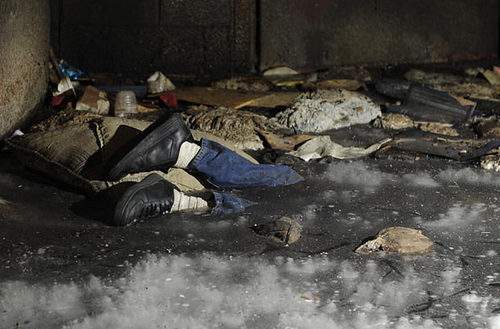
 BY JEFF DEENEY This morning’s Inquirer story on Camden’s tent city strikes me as a step backwards in the paper’s coverage of the homelessness issue. Last year Inky reporter Jennifer Lin made incredible strides towards covering the region’s homelessness problem the way it should be covered. Chronic street homelessness is a mental health and addictions crisis. There are professionals in the field who are applying new methods of attacking the problem, which has resulted in precipitous drops of people living on the streets in cities around the country. This new method of attacking homelessness is called “housing first” and it involves bundling permanent housing resources with the kind of intensive community mental health and addictions resources that can help someone coming off the streets, stay off the streets.
BY JEFF DEENEY This morning’s Inquirer story on Camden’s tent city strikes me as a step backwards in the paper’s coverage of the homelessness issue. Last year Inky reporter Jennifer Lin made incredible strides towards covering the region’s homelessness problem the way it should be covered. Chronic street homelessness is a mental health and addictions crisis. There are professionals in the field who are applying new methods of attacking the problem, which has resulted in precipitous drops of people living on the streets in cities around the country. This new method of attacking homelessness is called “housing first” and it involves bundling permanent housing resources with the kind of intensive community mental health and addictions resources that can help someone coming off the streets, stay off the streets.
Housing first has a substantial track record of efficacy at this point. It was refreshing to see the Inky finally give the subject the serious treatment it deserved, their reporters finally connecting with the serious professionals who do this work. In years past the paper has continually spotlighted the charity groups and do-gooders whose efforts to help the homeless, while certainly not without merit, aren’t going to get people out of the cold and into permanent homes. During that time other newspapers in other cities were out in front covering the housing first story, and winning accolades for doing so.
I was hoping Jennifer Lin would be the permanent regional homelessness reporter; the Inky likes to run homelessness coverage a lot, especially during the winter, so having someone who’s plugged into what’s happening in the field strikes me as important. It also strikes me that reporter Matt Katz is not plugged into the what’s happening in the field and didn’t try very hard to find out. He starts by framing his story as a mental health story, describing the delusions one of the tent city’s occupants. He then proceeds to describe the personal stories of a number of other homeless men and women, many of whom also suffer from mental illness. However, at no point in the article does Katz contact any mental health professionals in the region to find out what, if anything, is being done in Camden, and what needs to be done to try to fix the city’s mounting homelessness problem. [continues after the jump]
That’s unfortunate, because just last November I wrote a commentary piece about Jennifer Lin’s last bit of competent coverage where I mentioned exactly the group Katz should have been talking to for his story:
“While not included in (Jennifer Lin’s) story, it’s also worth noting that Resources for Human Development is currently developing a housing first program based on (NYU psychiatrist and housing first pioneer) SamTsemberis’s model to be implemented among Camden’s heroin addicted homeless population.”
Katz’s story leaves you with the impression that mental health and social service professionals have no idea what to do about Camden’s homelessness problem, nor are there any competent providers scrambling at this very moment to get programs implemented that can have an impact on it. That’s simply not true. The questionnaire that Katz reports homeless people were filling out for social service professionals is not intended to provide critical insights that could lead to new models of service provision, as his representation implies. Consumer input is important for social service professionals, but that’s not where they look when developing new best practices.
The model for effectively combating the homelessness problem already exists, however, it’s been slow to take hold in the region and is only just getting under way in Camden. The rolling out of a new housing first program, the first of its kind in Camden, is a huge development from an industry perspective. Resources for Human Development has a wealth of experience serving the mental health and addiction needs of this population. In my opinion, comments from RHD and other serious service providers should have been in this article. That is, their comments should have been included if the Inky was aware of their efforts, and was really trying to get an informed perspective on what’s happening to combat Camden’s homelessness problem.
ABOUT THE AUTHOR: Jeff Deeney is a freelance writer whose work has appeared in PW, City Paper and the Inquirer. He focuses on issues of urban poverty and drug culture. He is currently working on a book about life in the crossfire of poverty, drugs, guns, and the bureaucracies designed to remedy them, all of which informed his experiences as social workers in some of the city’s most dire and depleted neighborhoods.
OBSCENE: Homeless Man Encased In Ice, Meanwhile Life Goes On All Around Him

DETROIT NEWS: It starts with a phone call made by a man who said his friend found a dead body in the elevator shaft of an abandoned building on the city’s west side. “He’s encased in ice, except his legs, which are sticking out like Popsicle sticks,” the caller phoned to tell this reporter. “Why didn’t your friend call the police?”
“He was trespassing and didn’t want to get in trouble,” the caller replied. As it happens, the caller’s friend is an urban explorer who gets thrills rummaging through and photographing the ruins of Detroit. It turns out that this explorer last week was playing hockey with a group of other explorers on the frozen waters that had collected in the basement of the building. None of the men called the police, the explorer said. They, in fact, continued their hockey game.
Before calling the police, this reporter went to check on the tip, skeptical of a hoax. Sure enough, in the well of the cargo elevator, two feet jutted out above the ice. Closer inspection revealed that the rest of the body was encased in 2-3 feet of ice, the body prostrate, suspended into the ice like a porpoising walrus.
The hem of a beige jacket could be made out, as could the cuffs of blue jeans. The socks were relatively clean and white. The left shoe was worn at the heel but carried fresh laces. Adding to the macabre and incongruous scene was a pillow that gently propped up the left foot of the corpse. It looked almost peaceful. MORE
